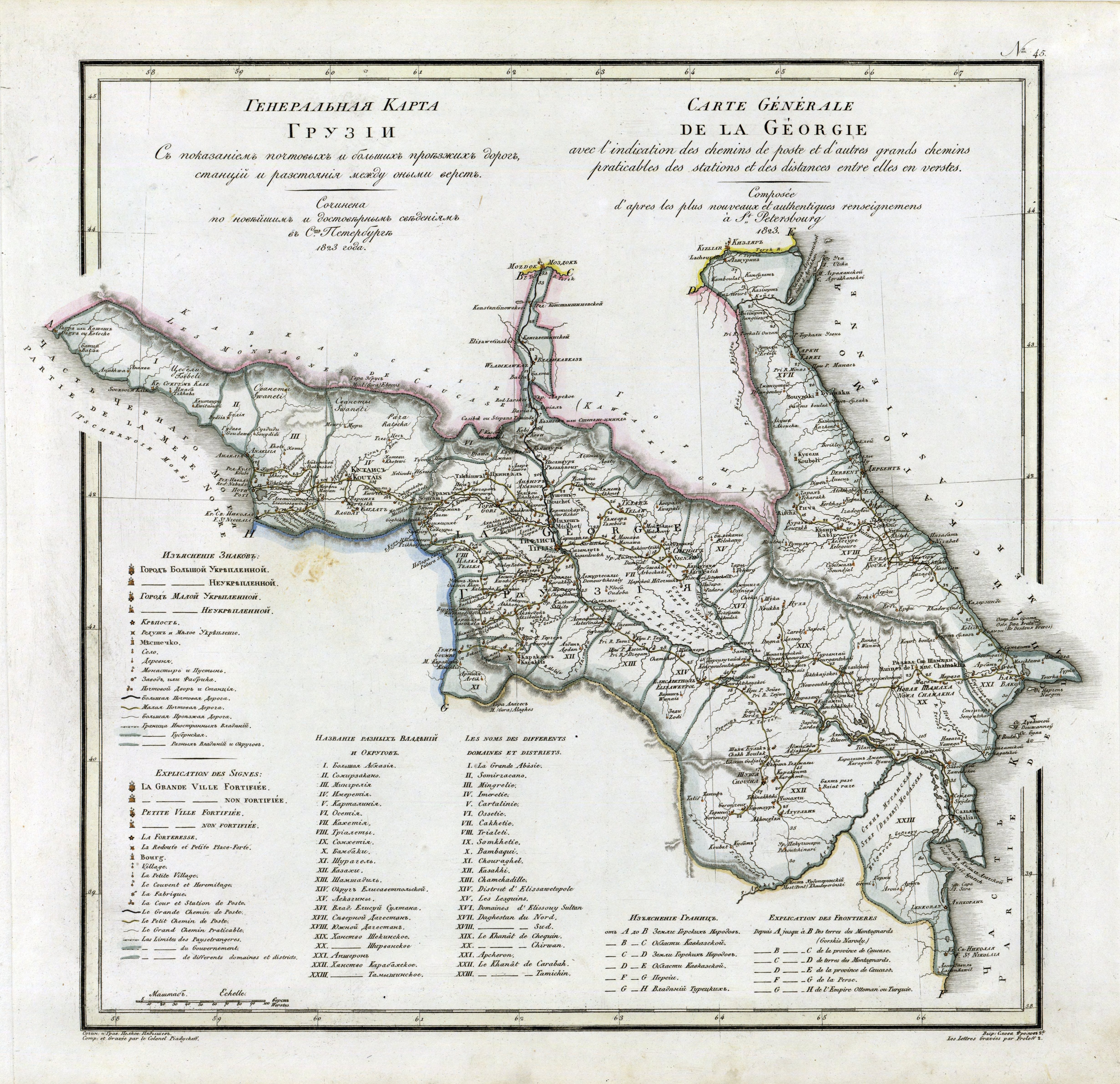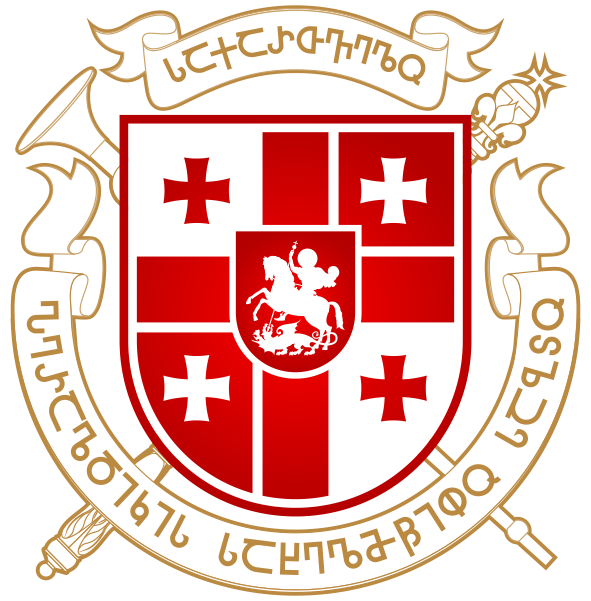|
Rusishvili
The House of Rusishvili ( ka, რუსიშვილი) is the name of the Georgian noble family. History The Rusishvili were a princely family, '' tavadi'', in the eastern Georgian kingdom of Kakheti. A genealogical tradition enshrined in the writings of Prince Ioann of Georgia (1768–1830) traces the family's ancestry to the late 12th century, making them descended from a Rus guardsman of Prince Yuri of Novgorod, the first husband of Queen Regnant Tamar of Georgia. Yuri's guardsman is said to have stayed in Georgia and ennobled by Tamar. His progeny allegedly adopted the surname of Rusishvili, literally "children or scions of the Rus". The family is included in the list of the Georgian nobility attached to the Russo-Georgian treaty of Georgievsk of 1783. Members of the family occupied the office of Chief Treasurer at the court of the kings of Kakheti and, since 1724, the episcopal sea of Nekresi. After the Russian annexation of Georgia, the family was confirmed amon ... [...More Info...] [...Related Items...] OR: [Wikipedia] [Google] [Baidu] |
Georgia (country)
Georgia (, ; ) is a transcontinental country at the intersection of Eastern Europe and Western Asia. It is part of the Caucasus region, bounded by the Black Sea to the west, by Russia to the north and northeast, by Turkey to the southwest, by Armenia to the south, and by Azerbaijan to the southeast. The country covers an area of , and has a population of 3.7 million people. Tbilisi is its capital as well as its largest city, home to roughly a third of the Georgian population. During the classical era, several independent kingdoms became established in what is now Georgia, such as Colchis and Iberia. In the early 4th century, ethnic Georgians officially adopted Christianity, which contributed to the spiritual and political unification of the early Georgian states. In the Middle Ages, the unified Kingdom of Georgia emerged and reached its Golden Age during the reign of King David IV and Queen Tamar in the 12th and early 13th centuries. Thereafter, the kingdom decl ... [...More Info...] [...Related Items...] OR: [Wikipedia] [Google] [Baidu] |
Georgia Within The Russian Empire
The country of Georgia became part of the Russian Empire in the 19th century. Throughout the early modern period, the Muslim Ottoman and Persian empires had fought over various fragmented Georgian kingdoms and principalities; by the 18th century, Russia emerged as the new imperial power in the region. Since Russia was an Orthodox Christian state like Georgia, the Georgians increasingly sought Russian help. In 1783, Heraclius II of the eastern Georgian kingdom of Kartli-Kakheti forged an alliance with the Russian Empire, whereby the kingdom became a Russian protectorate and abjured any dependence on its suzerain Persia. The Russo-Georgian alliance, however, backfired as Russia was unwilling to fulfill the terms of the treaty, proceeding to annex the troubled kingdom in 1801, and reducing it to the status of a guberniya, Russian region (Georgia Governorate). In 1810, the western Georgian kingdom of Kingdom of Imereti, Imereti was annexed as well. Russian rule over Georgia was ev ... [...More Info...] [...Related Items...] OR: [Wikipedia] [Google] [Baidu] |
State Council Of Heraldry
The State Council of Heraldry at the Parliament of Georgia ( ka, საქართველოს პარლამენტთან არსებული ჰერალდიკის სახელმწიფო საბჭო,''sakartvelos parlamentan arsebuli heraldikis sakhelmtsipo sabcho'') is a heraldic authority in Georgia (country), Georgia, established at the Parliament of Georgia on February 29, 2008. Located in Tbilisi, the council advises the government of Georgia on all matters related to heraldry. The council is headed by a chairman who is appointed (and dismissed) by the chairperson of the Parliament of Georgia. Since its creation in 2008, the council has been chaired by Eldar Shengelaya. Mamuka Gongadze is deputy chairman of the State Council of Heraldry at the Parliament of Georgia. The State Co ... [...More Info...] [...Related Items...] OR: [Wikipedia] [Google] [Baidu] |
Coat Of Arms
A coat of arms is a heraldry, heraldic communication design, visual design on an escutcheon (heraldry), escutcheon (i.e., shield), surcoat, or tabard (the latter two being outer garments). The coat of arms on an escutcheon forms the central element of the full achievement (heraldry), heraldic achievement, which in its whole consists of a shield, supporters, a crest (heraldry), crest, and a motto. A coat of arms is traditionally unique to an individual person, family, state, organization, school or corporation. The term itself of 'coat of arms' describing in modern times just the heraldic design, originates from the description of the entire medieval chainmail 'surcoat' garment used in combat or preparation for the latter. Roll of arms, Rolls of arms are collections of many coats of arms, and since the early Modern Age centuries, they have been a source of information for public showing and tracing the membership of a nobility, noble family, and therefore its genealogy across tim ... [...More Info...] [...Related Items...] OR: [Wikipedia] [Google] [Baidu] |
Georgetown University Press
Georgetown University Press is a university press affiliated with Georgetown University that publishes about forty new books a year. The press's major subject areas include bioethics, international affairs, languages and linguistics, political science, public policy, and religion. It was founded in 1964, and is a member of the Association of American University Presses (AAUP) and a founding member of the Association of Jesuit University Presses (AJUP). The press publishes the '' Al-Kitaab'' series, the most widely used set of Arabic language textbook series in the United States. It also publishes textbooks and digital materials for other languages including Spanish, Mandarin Chinese, Iraqi Arabic, Moroccan Arabic, Syrian Arabic, Portuguese Portuguese may refer to: * anything of, from, or related to the country and nation of Portugal ** Portuguese cuisine, traditional foods ** Portuguese language, a Romance language *** Portuguese dialects, variants of the Portuguese language ... [...More Info...] [...Related Items...] OR: [Wikipedia] [Google] [Baidu] |
Cyril Toumanoff
Cyril Leo Toumanoff (russian: Кирилл Львович Туманов; 13 October 1913 – 4 February 1997) was a Russian-born Georgian historian and genealogist who mostly specialized in the history and genealogies of medieval Georgia, Armenia, Iran and the Byzantine Empire. His works have significantly influenced the Western scholarship of the medieval Caucasus. Robert H. Hewsen. "In Memoriam: Cyril Toumanoff." ''Journal of the Society for Armenian Studies''. Vol. 8, 1995, 5–7. Family Cyril Toumanoff was born in Saint Petersburg into a family of the military officer of the Russian army. His father's ancestors came of the princely family of Tumanishvili (Tumanov) from Georgia,Rapp, Stephen H. (2003), ''Studies In Medieval Georgian Historiography: Early Texts And Eurasian Contexts'', p. 16. Peeters Bvba, .For the present investigation no single scholar's body of work has had a greater impact than that of Cyril Toumanoff (1913 -1997). Born in St. Peterburg of an old Armeno-Geor ... [...More Info...] [...Related Items...] OR: [Wikipedia] [Google] [Baidu] |
Russian Empire
The Russian Empire was an empire and the final period of the Russian monarchy from 1721 to 1917, ruling across large parts of Eurasia. It succeeded the Tsardom of Russia following the Treaty of Nystad, which ended the Great Northern War. The rise of the Russian Empire coincided with the decline of neighbouring rival powers: the Swedish Empire, the Polish–Lithuanian Commonwealth, Qajar Iran, the Ottoman Empire, and Qing China. It also held colonies in North America between 1799 and 1867. Covering an area of approximately , it remains the third-largest empire in history, surpassed only by the British Empire and the Mongol Empire; it ruled over a population of 125.6 million people per the 1897 Russian census, which was the only census carried out during the entire imperial period. Owing to its geographic extent across three continents at its peak, it featured great ethnic, linguistic, religious, and economic diversity. From the 10th–17th centuries, the land ... [...More Info...] [...Related Items...] OR: [Wikipedia] [Google] [Baidu] |
Knyaz
, or ( Old Church Slavonic: Кнѧзь) is a historical Slavic title, used both as a royal and noble title in different times of history and different ancient Slavic lands. It is usually translated into English as prince or duke, depending on specific historical context and the potentially known Latin equivalents of the title for each bearer of the name. In Latin sources the title is usually translated as , but the word was originally derived from the common Germanic (king). The female form transliterated from Bulgarian and Russian is (), in Slovene and Serbo-Croatian (Serbian Cyrillic: ), ''kniahinia'' (княгіня) in Belarusian and ''kniazioŭna'' (князёўна) is the daughter of the prince, (княгиня) in Ukrainian. In Russian, the daughter of a knyaz is (). In Russian, the son of a knyaz is ( in its old form). The title is pronounced and written similarly in different European languages. In Serbo-Croatian and some West Slavic languages, the word ... [...More Info...] [...Related Items...] OR: [Wikipedia] [Google] [Baidu] |
Nekresi
Nekresi ( ka, ნეკრესი) is a historic and archaeological site in eastern Georgian region of Kakheti, between the town of Qvareli and the village of Shilda, at the foothills of the Greater Caucasus mountains. It is home to the still-functioning Nekresi monastery, founded in the 6th century. Nekresi is known from the early medieval Georgian sources as a once flourishing town of Antiquity. A series of archaeological expeditions, beginning in 1984, have uncovered various features of a large settlement, but its extents remain unknown owing to a densely forested landscape and lack of written sources. Several major structures, unearthed across the site and mostly dated to the Late Antiquity, bear traces of earthquakes and violent destruction. Nekresi was reduced to a village or a number of hamlets in the 8th century. Its principal monastery remained functional, but the town itself became engulfed in foliage and gradually disappeared from historical memory until its rediscov ... [...More Info...] [...Related Items...] OR: [Wikipedia] [Google] [Baidu] |
Tavadi
''Tavadi'' ( ka, თავადი, "prince", lit. "head/chief" [man], from ka, თავი ''tavi'', "head", with the prefix of agent ''-di'') was a feudal title in Georgia (country), Georgia first applied in the Late Middle Ages usually translated in English language, English as Prince (most commonly) and Duke (less commonly). The title was designated for dynastic princes who were heads of families, akin to mtavari who had a higher standing. The tavadis were subordinates and vassals of the kings, Queen regnant, queens, mtavaris and batonishvilis but had administrative, judicial and tax immunities in their dominions and had their own military forces. The lower noble feudal class of Georgia had the title of aznauri who were subordinates of tavadis. See also *List of Georgian princely families *Court officials of the Kingdom of Georgia References *Jamburia G. Georgian Soviet Encyclopedia, Volume 4, p. 561-562, Tbilisi, 1979 Social history of Georgia (country) Nobilit ... [...More Info...] [...Related Items...] OR: [Wikipedia] [Google] [Baidu] |
Treaty Of Georgievsk
The Treaty of Georgievsk (russian: Георгиевский трактат, Georgievskiy traktat; ka, გეორგიევსკის ტრაქტატი, tr) was a bilateral treaty concluded between the Russian Empire and the east Georgian kingdom of Kartli-Kakheti on July 24, 1783. The treaty established eastern Georgia as a protectorate of Russia, which guaranteed its territorial integrity and the continuation of its reigning Bagrationi dynasty in return for prerogatives in the conduct of Georgian foreign affairs.Anchabadze, George, Ph.D. History of GeorgiaGeorgia in the Beginning of Feudal Decomposition. (XVIII cen.) Retrieved 5 April 2012. By this, eastern Georgia abjured any form of dependence on Persia (who had been its suzerain for centuries) or another power, and every new Georgian monarch of Kartli-Kakheti would require the confirmation and investiture of the Russian tsar. Terms Under articles I, II, IV, VI and VII of the treaty's terms, Russia's empress bec ... [...More Info...] [...Related Items...] OR: [Wikipedia] [Google] [Baidu] |





.jpg)
